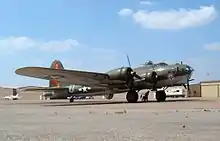Thunderbird (aircraft)
Thunderbird was a high mission tally Boeing B-17G Flying Fortress of the 303rd Bombardment Group during World War II. The original plane, serial number 42-38050, was scrapped at the end of the war and no longer exists. It is now represented by a mural in the WWII gallery of the National Air & Space Museum on the Mall in Washington, DC.
| Thunderbird | |
|---|---|
 | |
| LSFM B-17G Thunderbird in flight with a B-52H at 2006 Defenders of Liberty Airshow at Barksdale Air Force Base, La., May 12, 2006. | |
| Type | Boeing B-17G Flying Fortress |
| Manufacturer | Douglas Aircraft Company |
| Serial | 42-38050 |
| First flight | 1943 |
| In service | November 1943 to 22 March 1945 |
| Fate | Retired to the Kingman, Arizona aircraft disposal plant |
| Preserved at | Replica currently flying with the Lone Star Flight Museum |
The name also appears on a later B-17G. That restoration and replica of Thunderbird is one of the few surviving flyable B-17s, and is the largest aircraft housed at the Lone Star Flight Museum, in Houston, Texas.
The demonstration aircraft was completed on May 8, 1945, at the end of hostilities in the European theater of World War II.[1] She was originally B-17G-105-VE 44-85718 and is now painted to replicate a noted veteran WWII bomber of the 359th Bomb Squadron, 303rd Bomb Group, part of the U.S. Eighth Air Force, based at RAF Molesworth, England.
Thunderbird's history

_-Wings_Over_Houston_air_show%252C_USA_-15Oct2011.jpg.webp)
The aircraft represented was also a B-17G, serial number 42-38050. She was a B-17G-25-DL manufactured by Douglas Aircraft Company in Long Beach, California, and flew 112 combat missions with the 303rd Bomb Group. She was accepted by the USAAF in November 1943 and arrived in the group on January 18, 1944, at RAF Molesworth, England.
On January 23, 1944, she was assigned to the crew of 1st Lt. Vern L. Moncur, of Rupert, Idaho and Bountiful, Utah, which had six previous missions in other bombers. After that crew completed her tour on April 10, she was used as a “new crew” aircraft, used to break in replacement crews, although eight of the missions were flown by the crew of 1st Lt. Richard K. Marsh between April 11 and June 2.
She flew her first mission on January 29, 1944 (Frankfurt, Germany), and her last on March 22, 1945 (Gelsenkirchen, Germany), after which she was retired as "war weary". Returned to the United States after the war, she was sent to Kingman, Arizona, where unlike her LSFM counterpart, she was scrapped. She reputedly was crewed by 538 different airmen, none of whom suffered an injury aboard Thunderbird.
The original Thunderbird is the subject of a 25-by-75-foot mural in the World War II Gallery of the Smithsonian Institution's National Air and Space Museum on the National Mall entitled "Fortresses Under Fire", completed 1975–1976. The artist, Keith Ferris, depicted Thunderbird on her 70th mission at 11:45 a.m., August 15, 1944, over Trier, Germany, on her return to Molesworth following a mission to bomb Wiesbaden, and is historically accurate in the encounter portrayed.[2]
Ferris used Thunderbird as the centerpiece of two other paintings, "Retirement Party for Old Thunderbird" (1965 for the Air Force Art Collection), showing the bomber on her 112th and last mission, and "Schweinfurt Again", depicting the bomber on her 76th mission in October 1944.[3]
Notes
| Wikimedia Commons has media related to Thunderbird (B-17). |

- Lone Star Flight Museum commemorative reference plaque.
- "Fortresses Under Fire". keithferrisart.com. Archived from the original on May 4, 2014. Retrieved Jan 10, 2014.
- "Thunderbird Art". 303rd Bomb group Assn. Retrieved April 22, 2007. This site also lists every mission and crewman making an operational flight on Thunderbird, among other data.
Sources
- O'Leary, Michael. "Thunderbird", Air Classics, August 2004. Challenge Publications, inc.
- B-17 Thunderbird.com memorial site